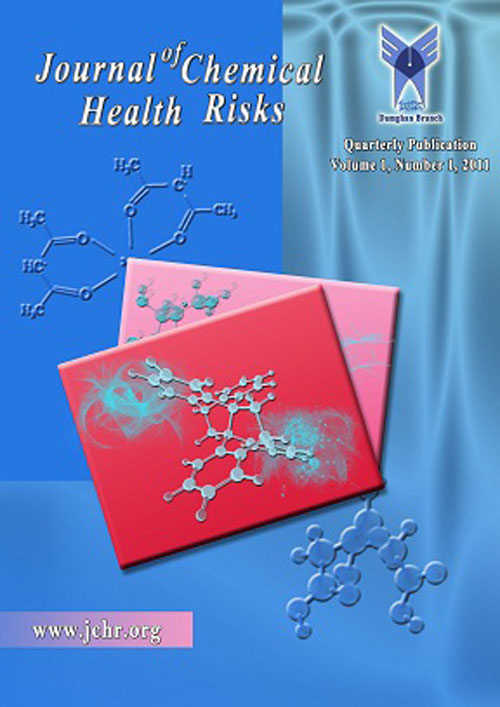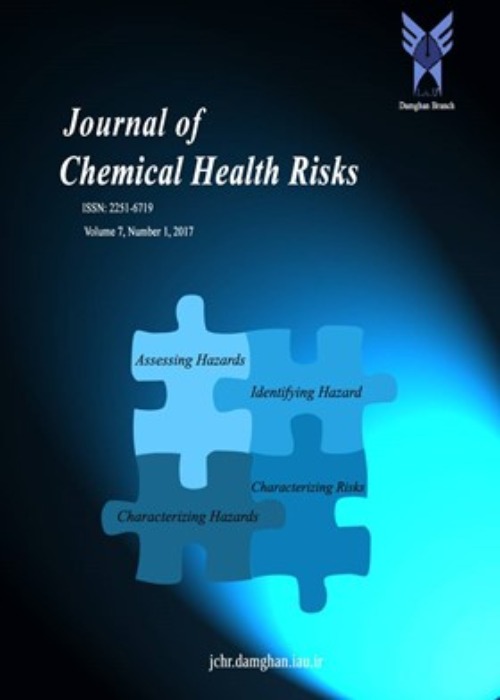فهرست مطالب

Journal of Chemical Health Risks
Volume:5 Issue: 1, Winter 2015
- تاریخ انتشار: 1393/11/23
- تعداد عناوین: 8
-
-
Page 1The objective of the present study was to evaluate the effect of metal mobilizing agents, ethelynediaminetetraacetic acid (EDTA) and salicylic acid (SA), on the accumulation and translocation of lead (Pb) and nickel (Ni) by fenugreek (Trigonellafoenum-graecumL.) plants in contaminated soil. EDTA and SA were amended at 100 mM and 1.0 mM respectively. Pb and Ni content were estimated using ICP-OES. Plant samples were prepared for scanning electron microscope (SEM) analysis to investigate metals distribution in different tissues (root, stem and leaf) of plant. The results showed that EDTA increased Pb and Ni uptake as compared to SA. SEM analysis revealed that in the presence of EDTA, the deposition of Pb particles was predominantly in vascular tissues of the stem and leaf.Keywords: Induced phyto, extraction Lead Nickel Fenugreek EDTA Salicylic acid
-
Page 15Echinacea purpurea is an herbaceous perennial plant as members of the Asteraceae family. It is one the important medicinal plant in pharmacy industrial. Active substances of Echinaceae are amplifier of body''s immune system and antivirus. Echinacea is not native to Iran. The phytochemical traits of medicinal plants depend on ecological conditions involving growing areas, climate conditions; various grow stages and genetic modifications. The aim of this study was the evaluation of cichoric acid of E. purpurea extract in different ecological conditions in Semnan, Iran. Dormancy in seeds was broken by treating them with strafication in 4 °C for 48 h, was grown in nursery beds for autumn and early winter and transfered to four areas with different ecological conditions in late winter. Chashm, Ahuvan, Semnan and Foladmahale were chosen for this experiment. The spacing of plantlet was about 25 × 45 cm in the field. After 2- 3 months, aerial parts of the plants collected in all areas and extract samples were prepared and characterized using high- performance liquid chromatography (HPLC). The components of a basic HPLC system were shown significant values of the cichoric acid in plants under four habitats. The level of cichoric acid in one condition was more than standards level that reported in another references. In addition, ecological diversities have significant impacts the quantity of cichoric acid in E. purpurea.Keywords: Echinacea purpurea Extract Cichoric acid HPLC
-
Page 21Cheese has high nutritional value in human health although is naturally poor in essential fatty acids. Essential fatty acids revealed crucial roles in nutritional diet and have been suggested as disease prevention agent. Protulaca Oleracea (purslane) has considerable amounts of omega 3, 6 and 9 fatty acids as well as magnesium, potassium and vitamin C. The aim of this study is production and characterization of Lighvan cheese fortified with Protulaca Oleracea seed oil. Results indicated that increasing of Protulaca Oleracea seed oil caused significant increased omega 3,6 and 9 concentration in cheese (P<0.05). Protulaca Oleracea seed oil fortification showed no significant effects on physicochemical properties of Lighvan cheese (P>0.05). Lighvan cheese containing 2.5% Protulaca Oleracea (purslane) seed oil showed the highest sensory attributes.Keywords: Omega 3, 6, 9 fatty acids Lighvan cheese Protulaca Oleracea seed oil
-
Page 29In this research, chitosan was used for the removal of Cr (VI) ions from aqueous solution. The effect of parameters like solution pH, initial Cr (VI) concentration, agitation time, amount of adsorbent and agitation speed on the adsorption process was studied. The experimental equilibrium data were analyzed by using various models such as Langmuir and Freundlich. Freundlich isotherm model fitted well with data. In addition, the experimental data was fitted to kinetic models including the pseudo-first-order and pseudo-second-order and based on calculated respective parameters such as rate constants, equilibrium adsorption capacities and correlation coefficients. The removal process follows the pseudo-second-order kinetic model. The results suggest that chitosan could be employed as a low-cost material for the removal of Cr(VI) ions from aqueous solutions.Keywords: Cr (VI) ions Chitosan Adsorption Removal efficiency
-
Page 39Drilling industry provides a significant potential for occupational health risks. Thus, health-related hazards (chemical, physical, ergonomic and biological) must be recognized, evaluated and controlled in order to prevent occupational illnesses which come from exposure to them. For these, a good occupational health risk assessment needs to be applied. Risk assessment monitors risks and provides guidance for decision-making. This project identifies all the occupational health risks and estimated risk levels. At last, the risk numbers are assessed their significance by the use of occupational health risk assessment techniques to minimize the risks. The main goal is to gain a level of risk protection which is acceptable with a good model. Therefore, the Occupational health risk assessment worksheet illustrates health hazards into four categories of every tasks of drilling industry. The risk categorized in the five levels and the high risks of Iranian drilling industry are those in the category of c.Keywords: Occupational health Risk assessment Hazard analysis Drilling industry
-
Page 45Magnesium alloys as biodegradable materials can be used in body as an implant materials but since they have poor corrosion resistance, it is required to decrease their corrosion rate by biocompatible coatings. In this study, hydroxyapatite (HA) coatings in the presence of an intermediate layer of ZrN as a biocompatible material, deposited on AZ91 magnesium alloy by ion beam sputtering method at 300 °C temperature and at different times 180, 240, 300, 360 and 420 min. Then changes in corrosion resistance of samples in Ringer''s solution as a solution similar to the human body was evaluated in two ways, potentiodynamic polarization and electrochemical impedance spectroscopy (EIS). To investigate the causes of the destruction of the samples, the surface of samples was studied by scanning electron microscopy (SEM). The results showed that because of porous coatings created, the corrosion potential of the samples was about +55mV higher than the uncoated substrate that by changing the deposition time, was not observed the significant change But with increasing deposition time to 360 min, corrosion current decreased which represents an increase of corrosion resistance of magnesium alloy in body solution. However, a further increase in deposition time to 420 min, due to increase thickness and stress in the layer, the corrosion resistance of the samples was reduced. The results of the EIS confirm the corrosion behavior of the polarization method, too.Keywords: Biodegradable alloy Corrosion Hydroxyapatite Sputtering
-
Page 55In this study, simple and efficient ultrasound-assisted emulsification microextraction (USAEME) combined with gas chromatography-flame ionization detector (GC-FID) was developed for the preconcentration and determination of carbamazepine in biological samples. In this method, the fine droplets of 1-octanol were formed and dispersed in the sample with the help of ultrasonic waves, which accelerated the formation of the fine cloudy solution without using disperser solvents. Several factors influencing the extraction efficiency such as the nature and volume of organic solvent, extraction temperature, ionic strength and centrifugation time were investigated and optimized. The new method (USAEME) provided detection limits of 0.6 µg L-1 and 1.2 µg L-1 in urine and plasma samples, respectively. The calibration graphs were linear in the range of 2.5-500 µg L-1 and 5.0-500 µg L-1 in urine and plasma, respectively. This proposed method was successfully applied to the analysis of carbamazepine in biological samples.Keywords: Ultrasound, assisted emulsification microextraction Carbamazepine Gas chromatography Biological samples
-
Investigation of Cosenza Mutation in Patients with Deficiency of Glucose-6-Phosphate Dehydrogenase (G6PD) in North West of IranPage 66The JCHR as a peer-review professional academic journal is striving to provide the best forum for researchers and scholars worldwide to exchange their latest findings and results. The journal is a multidisciplinary journal of chemistry, biology and public health will publish original researches and scientific articles describing studies of the toxic effects of chemical agents on human, environment and animal.Chemical Health Risk focuses on information and ideas relating to issues and advances in chemical health and safety.


